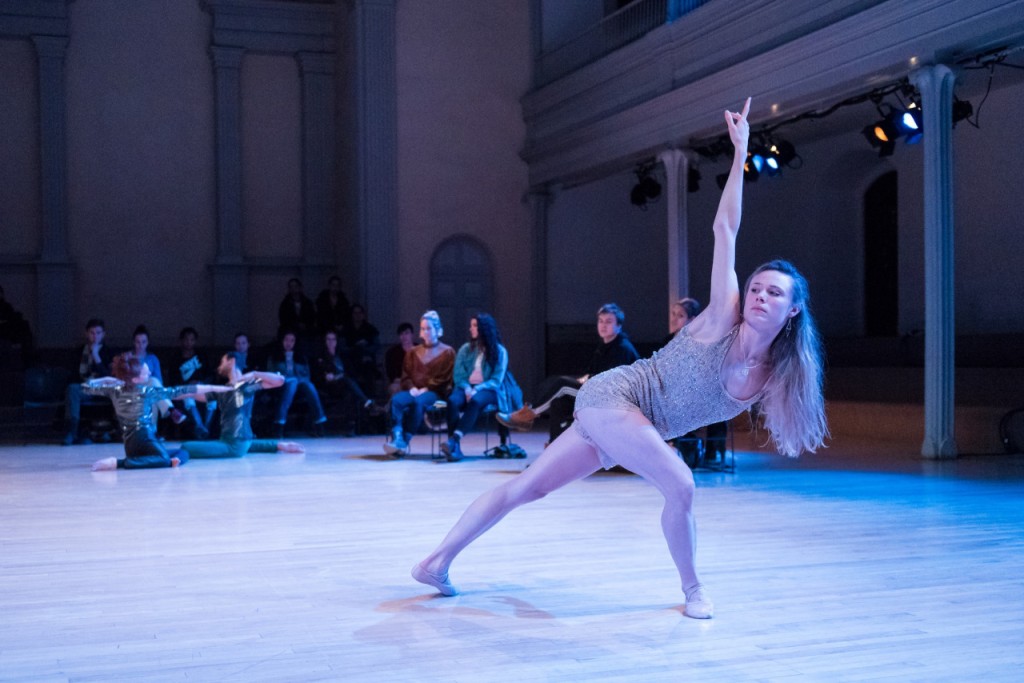“Dance Adjectives”
March 16, 2015
The adjectives were tentative. I rolled them in my mind. Writing coaches have told me the fewer adjectives the better. As a word-class, they said, adjectives are dependent on other words for their functionality; yet while I watched there was a steady rush of modifiers, incisive and free. To describe my experience I could say: the dance was very frenetic, lively, rattling, clanging, rolling, contorting, twisting, collaborative, joyous, chancy, energetic. Is this because a dance relies on the speed of passing time?
The indentations in passing time are valuable. At the beginning, I remember, while Claudia La Rocco gave her opening remarks, Jodi Melnick lay on the floor. She had gathered herself in a pose and her body was unmoving, only the blinking of her eyes and the rise and fall of her diaphragm. People walked in while she lay there; some checked their watches when they saw her. Had the performance began? A body had been incised in the middle of the room, a calming image.
Yet I had to labor toward calm. When I saw Melnick’s body on the floor, my mind made frightening associations. Even now I am not clear why I fought persisting gloom, or whether the afterimage I conjured was from a story or a photograph—but it was there, bodies piled on bodies, bodies expelled in the dark, felled by hunger or the harsh desert wind, waiting for the end to come. Days later, still confounded, I found a poem by Yvonne Rainer, “1977.” [1]
I dreamed of bodies burning at the edges
When I awoke my belly was cold as an abandoned stove
The streets were cleared, trees bent
The air so still, as though just inhaled
When next I noticed it was spring
The dance progressed. During “sleepwalker session with multiple deaths”, when Sterling Hyltin coached Jodi Melnick on how to make certain moves, or when Rashaun Mitchell folded himself in and out of chairs, there were intermittent sniggers. Sometimes a lone audience member would snigger, sometimes many audience members at once. I enjoyed the lone sniggers, someone finding funny what others didn’t; each person having an experience independent of, but in consortium with others. The chairs, four in all, proved capable of will: when you thought Mitchell had freed himself from them, they entangled him yet again. I didn’t think it was an entanglement that meant restraint. Instead, a frenulum: a connecting fold of membrane serving to support or restrain a part, just like the tongue.
Watching their “8 unfinished dances,” when the dancers walked about the room with the confidence of property owners, I thought the best moments were those when their gestures would become similar, one arched elbow imitating the other, or feet strutting at the same time. These dances, without middles or ends, seemed almost like the gyrating fits of fraternal worshippers; spread-out on a rostrum, hoping to reach ecstasy through enthusiasm and fervor. And also, as the room glowed in blue and red, reverberating with a tune by Azealia Banks, Mitchell’s brief frenetic solo served as a tribute to street dance, subway stunts, every unregulated graceful display.
I hadn’t known, at the time of listening to the dancers read, that the words were James Waring’s. “And Waring is being talked about again,” David Vaughan wrote in his essay in the Platform catalogue. He died in his early fifties, was in a sense peripatetic (a “dancer, choreographer, teacher, director, visual artist, designer, writer, and sometime composer.”) The sound I remember from the reading of his play and texts was a bellow from the hereafter, clear and reassuring, the convincing voice of a teacher. Vaughan wrote: “It may be said that Waring changed the life of anyone who came into his orbit. He told you what dance concerts and art shows to go to…” What reading Waring taught, in addition, was posthumous labor. Even in death, one’s work wasn’t done. [2]
– Emmanuel Iduma, in response to Dance Dialogues: Sara Mearns & Rashaun Mitchell, Sterling Hyltin & Jodi Melnick (March 5-7, 2015).

